Detailed Tender Request for Large Asset Project as per AS 4120-1994
VerifiedAdded on 2023/06/11
|9
|1578
|126
Report
AI Summary
This document presents a comprehensive tender request for a large asset project, adhering to Australian Standard AS 4120-1994. It defines the project in the context of a large asset, explains project justification and the contract process, and details the financing of the project. The document also identifies project conditions, project teams, and project processes, providing expected estimations for project labor, plant, materials, and subcontractors. Furthermore, it outlines requirements for project change, quality assurance and control, document management, reporting, governance, dispute resolution, arbitration, mediation, and safety. The report includes relevant references to support its claims and provide further reading on the subject, offering a holistic view of the tender request process for large asset projects.
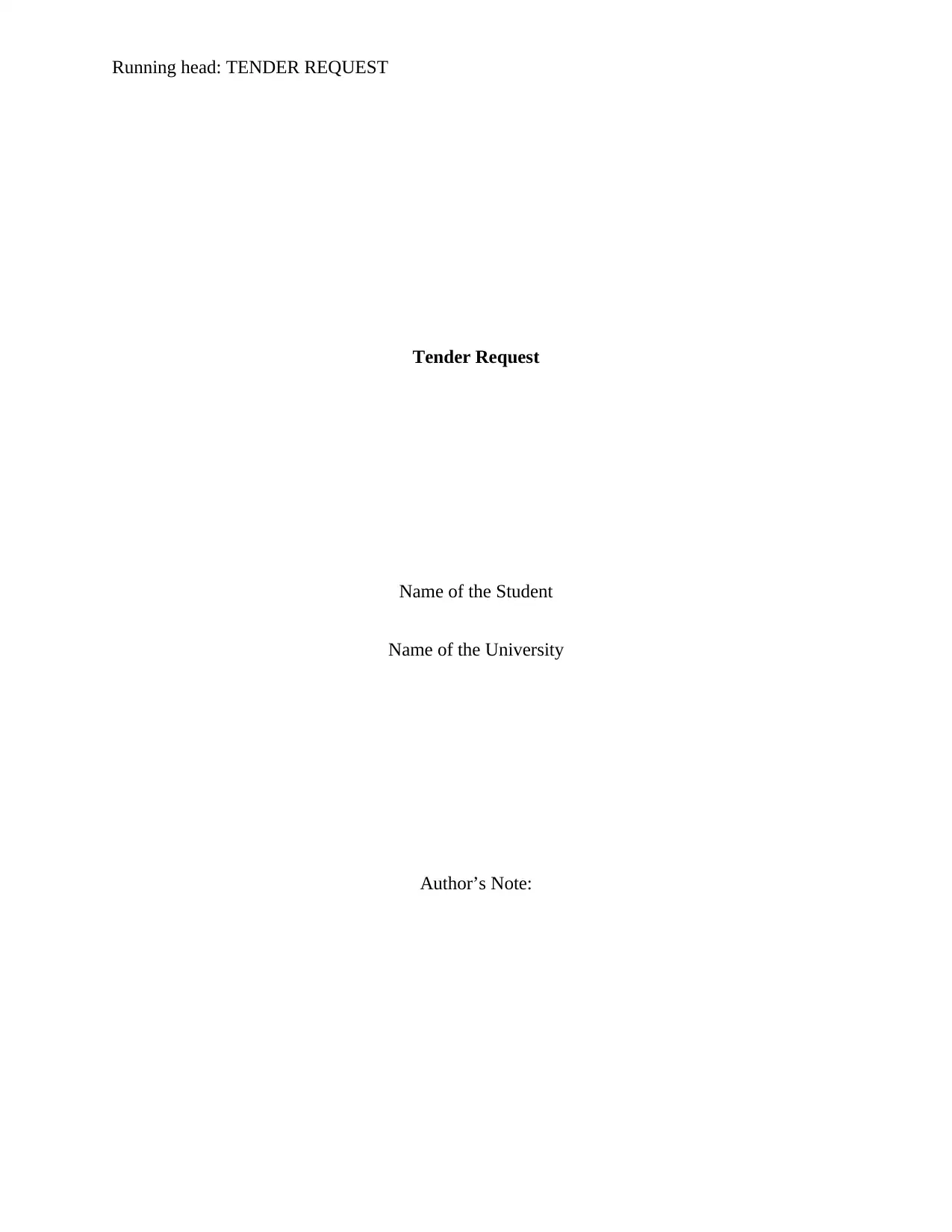
Running head: TENDER REQUEST
Tender Request
Name of the Student
Name of the University
Author’s Note:
Tender Request
Name of the Student
Name of the University
Author’s Note:
Paraphrase This Document
Need a fresh take? Get an instant paraphrase of this document with our AI Paraphraser
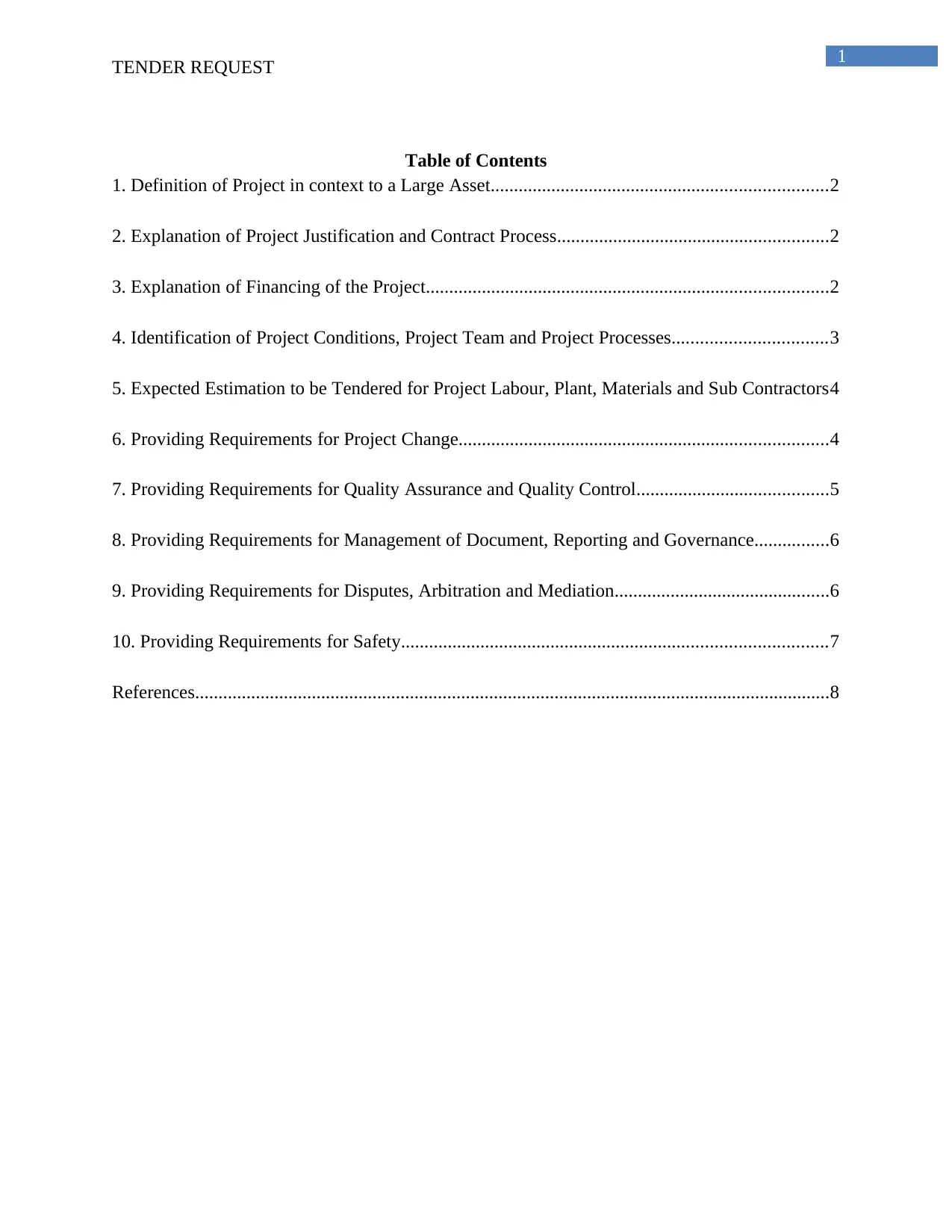
1
TENDER REQUEST
Table of Contents
1. Definition of Project in context to a Large Asset........................................................................2
2. Explanation of Project Justification and Contract Process..........................................................2
3. Explanation of Financing of the Project......................................................................................2
4. Identification of Project Conditions, Project Team and Project Processes.................................3
5. Expected Estimation to be Tendered for Project Labour, Plant, Materials and Sub Contractors4
6. Providing Requirements for Project Change...............................................................................4
7. Providing Requirements for Quality Assurance and Quality Control.........................................5
8. Providing Requirements for Management of Document, Reporting and Governance................6
9. Providing Requirements for Disputes, Arbitration and Mediation..............................................6
10. Providing Requirements for Safety...........................................................................................7
References........................................................................................................................................8
TENDER REQUEST
Table of Contents
1. Definition of Project in context to a Large Asset........................................................................2
2. Explanation of Project Justification and Contract Process..........................................................2
3. Explanation of Financing of the Project......................................................................................2
4. Identification of Project Conditions, Project Team and Project Processes.................................3
5. Expected Estimation to be Tendered for Project Labour, Plant, Materials and Sub Contractors4
6. Providing Requirements for Project Change...............................................................................4
7. Providing Requirements for Quality Assurance and Quality Control.........................................5
8. Providing Requirements for Management of Document, Reporting and Governance................6
9. Providing Requirements for Disputes, Arbitration and Mediation..............................................6
10. Providing Requirements for Safety...........................................................................................7
References........................................................................................................................................8
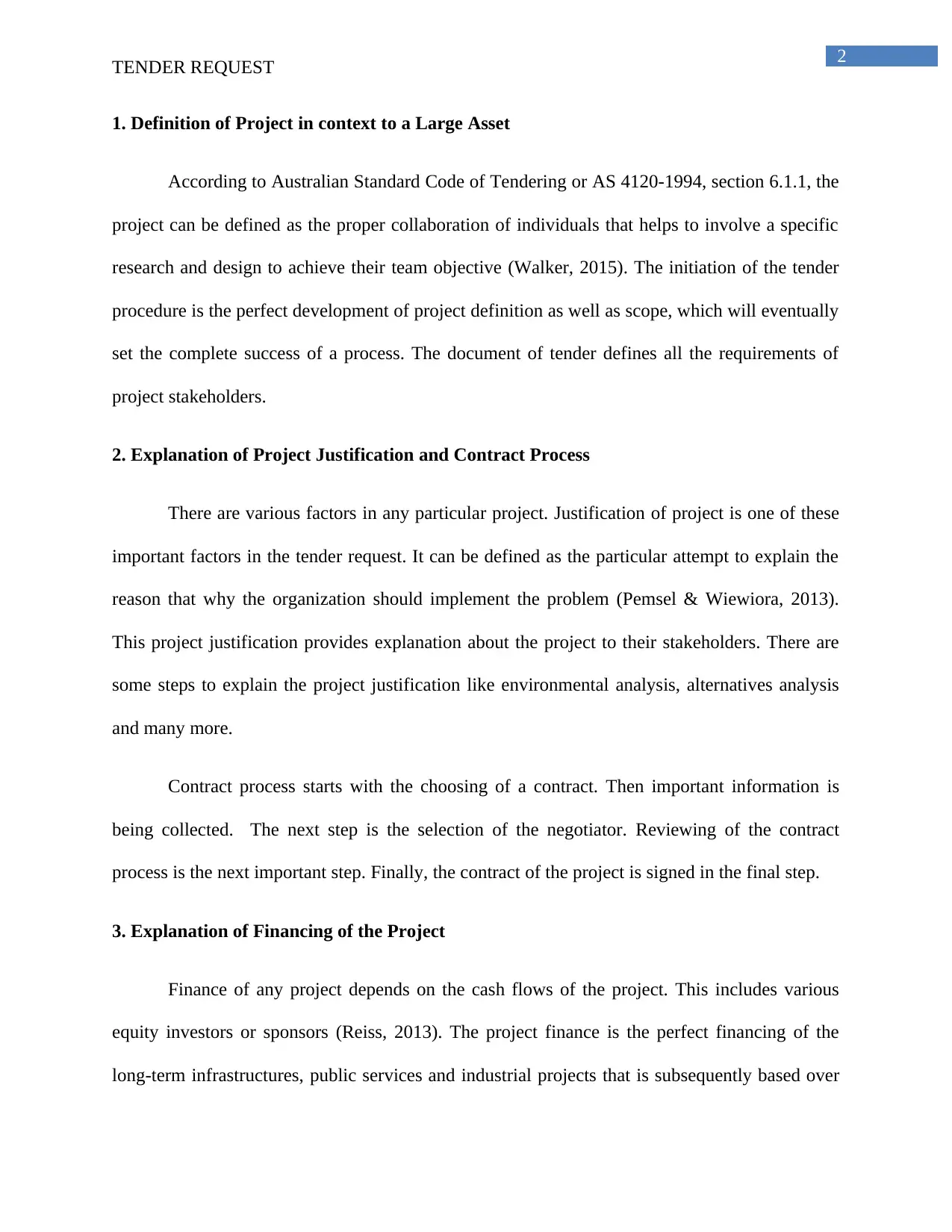
2
TENDER REQUEST
1. Definition of Project in context to a Large Asset
According to Australian Standard Code of Tendering or AS 4120-1994, section 6.1.1, the
project can be defined as the proper collaboration of individuals that helps to involve a specific
research and design to achieve their team objective (Walker, 2015). The initiation of the tender
procedure is the perfect development of project definition as well as scope, which will eventually
set the complete success of a process. The document of tender defines all the requirements of
project stakeholders.
2. Explanation of Project Justification and Contract Process
There are various factors in any particular project. Justification of project is one of these
important factors in the tender request. It can be defined as the particular attempt to explain the
reason that why the organization should implement the problem (Pemsel & Wiewiora, 2013).
This project justification provides explanation about the project to their stakeholders. There are
some steps to explain the project justification like environmental analysis, alternatives analysis
and many more.
Contract process starts with the choosing of a contract. Then important information is
being collected. The next step is the selection of the negotiator. Reviewing of the contract
process is the next important step. Finally, the contract of the project is signed in the final step.
3. Explanation of Financing of the Project
Finance of any project depends on the cash flows of the project. This includes various
equity investors or sponsors (Reiss, 2013). The project finance is the perfect financing of the
long-term infrastructures, public services and industrial projects that is subsequently based over
TENDER REQUEST
1. Definition of Project in context to a Large Asset
According to Australian Standard Code of Tendering or AS 4120-1994, section 6.1.1, the
project can be defined as the proper collaboration of individuals that helps to involve a specific
research and design to achieve their team objective (Walker, 2015). The initiation of the tender
procedure is the perfect development of project definition as well as scope, which will eventually
set the complete success of a process. The document of tender defines all the requirements of
project stakeholders.
2. Explanation of Project Justification and Contract Process
There are various factors in any particular project. Justification of project is one of these
important factors in the tender request. It can be defined as the particular attempt to explain the
reason that why the organization should implement the problem (Pemsel & Wiewiora, 2013).
This project justification provides explanation about the project to their stakeholders. There are
some steps to explain the project justification like environmental analysis, alternatives analysis
and many more.
Contract process starts with the choosing of a contract. Then important information is
being collected. The next step is the selection of the negotiator. Reviewing of the contract
process is the next important step. Finally, the contract of the project is signed in the final step.
3. Explanation of Financing of the Project
Finance of any project depends on the cash flows of the project. This includes various
equity investors or sponsors (Reiss, 2013). The project finance is the perfect financing of the
long-term infrastructures, public services and industrial projects that is subsequently based over
⊘ This is a preview!⊘
Do you want full access?
Subscribe today to unlock all pages.

Trusted by 1+ million students worldwide
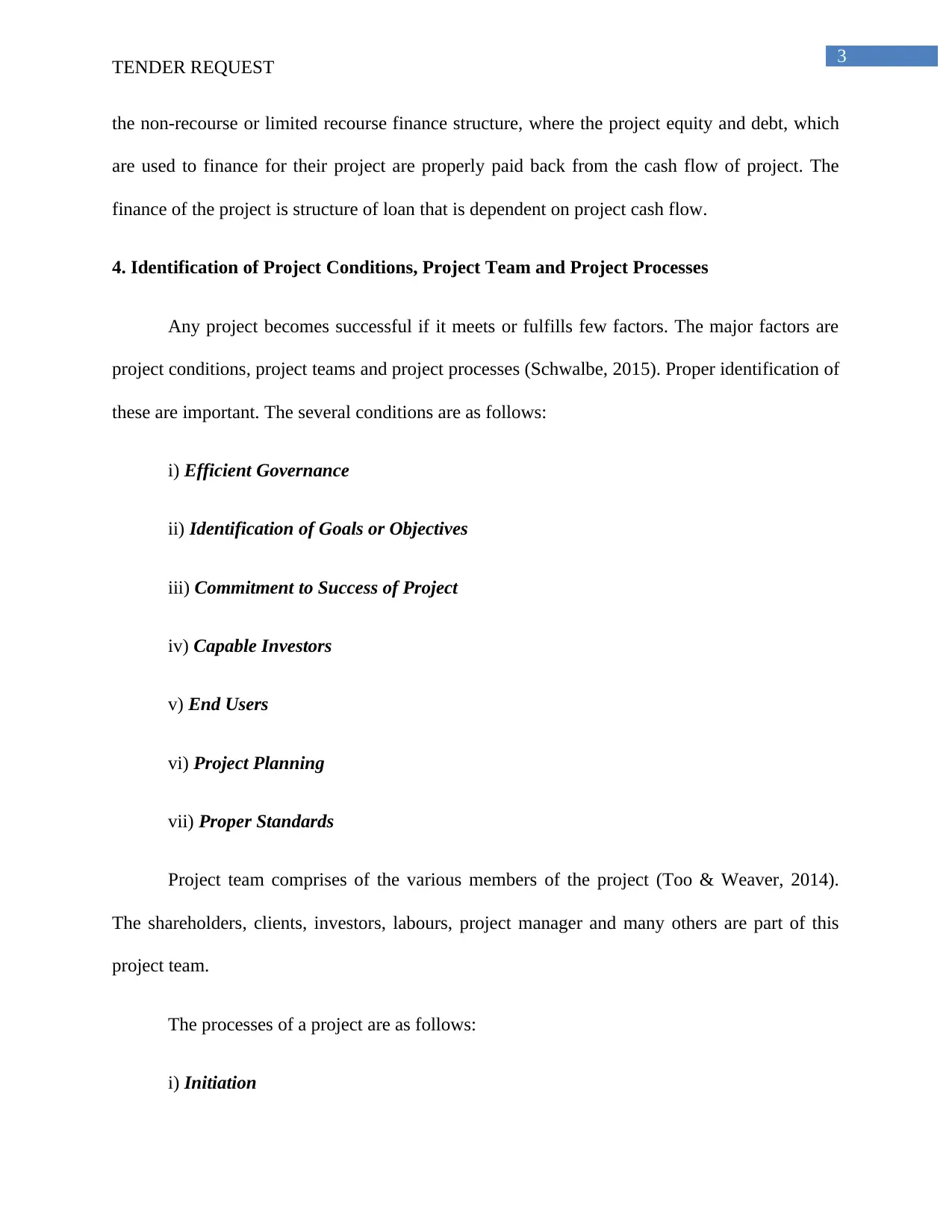
3
TENDER REQUEST
the non-recourse or limited recourse finance structure, where the project equity and debt, which
are used to finance for their project are properly paid back from the cash flow of project. The
finance of the project is structure of loan that is dependent on project cash flow.
4. Identification of Project Conditions, Project Team and Project Processes
Any project becomes successful if it meets or fulfills few factors. The major factors are
project conditions, project teams and project processes (Schwalbe, 2015). Proper identification of
these are important. The several conditions are as follows:
i) Efficient Governance
ii) Identification of Goals or Objectives
iii) Commitment to Success of Project
iv) Capable Investors
v) End Users
vi) Project Planning
vii) Proper Standards
Project team comprises of the various members of the project (Too & Weaver, 2014).
The shareholders, clients, investors, labours, project manager and many others are part of this
project team.
The processes of a project are as follows:
i) Initiation
TENDER REQUEST
the non-recourse or limited recourse finance structure, where the project equity and debt, which
are used to finance for their project are properly paid back from the cash flow of project. The
finance of the project is structure of loan that is dependent on project cash flow.
4. Identification of Project Conditions, Project Team and Project Processes
Any project becomes successful if it meets or fulfills few factors. The major factors are
project conditions, project teams and project processes (Schwalbe, 2015). Proper identification of
these are important. The several conditions are as follows:
i) Efficient Governance
ii) Identification of Goals or Objectives
iii) Commitment to Success of Project
iv) Capable Investors
v) End Users
vi) Project Planning
vii) Proper Standards
Project team comprises of the various members of the project (Too & Weaver, 2014).
The shareholders, clients, investors, labours, project manager and many others are part of this
project team.
The processes of a project are as follows:
i) Initiation
Paraphrase This Document
Need a fresh take? Get an instant paraphrase of this document with our AI Paraphraser
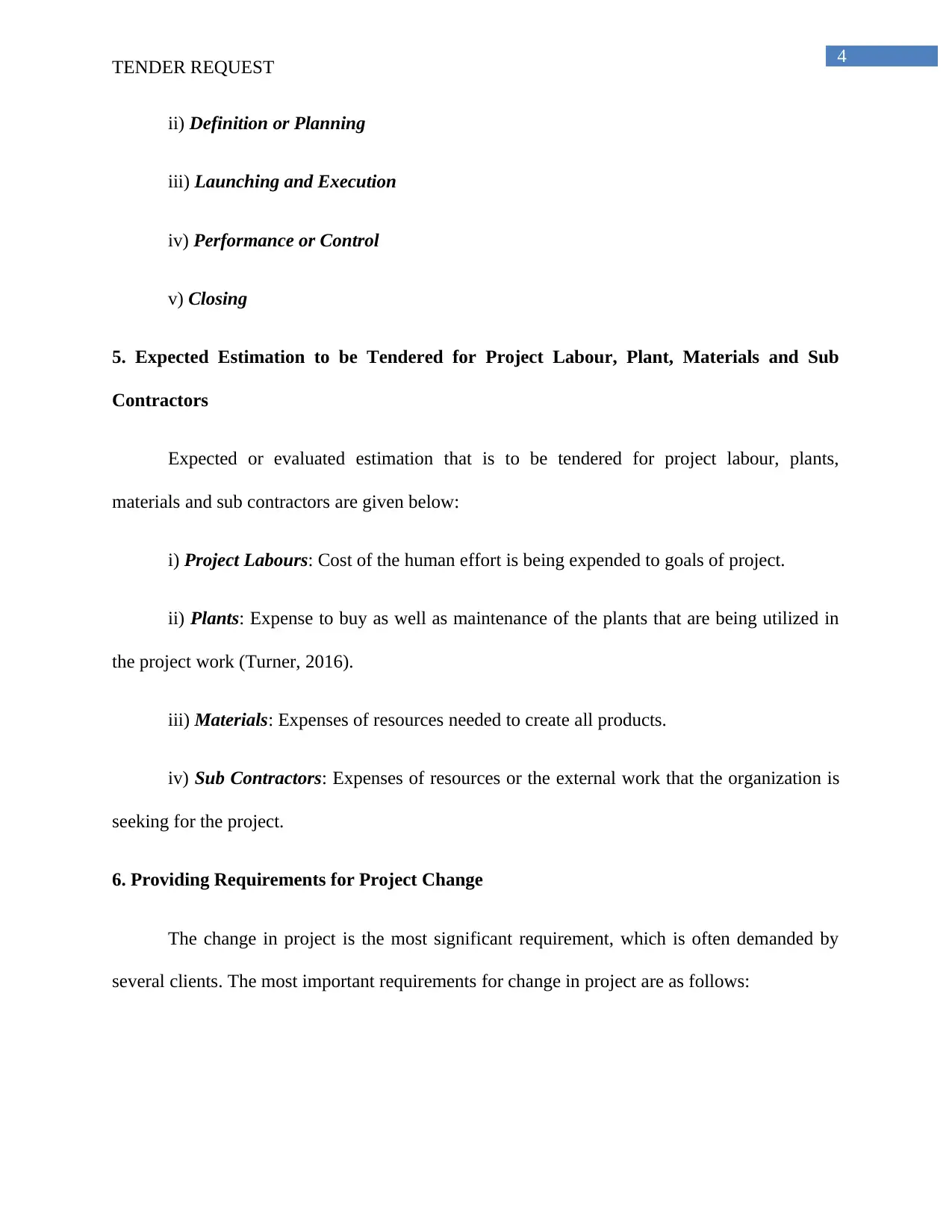
4
TENDER REQUEST
ii) Definition or Planning
iii) Launching and Execution
iv) Performance or Control
v) Closing
5. Expected Estimation to be Tendered for Project Labour, Plant, Materials and Sub
Contractors
Expected or evaluated estimation that is to be tendered for project labour, plants,
materials and sub contractors are given below:
i) Project Labours: Cost of the human effort is being expended to goals of project.
ii) Plants: Expense to buy as well as maintenance of the plants that are being utilized in
the project work (Turner, 2016).
iii) Materials: Expenses of resources needed to create all products.
iv) Sub Contractors: Expenses of resources or the external work that the organization is
seeking for the project.
6. Providing Requirements for Project Change
The change in project is the most significant requirement, which is often demanded by
several clients. The most important requirements for change in project are as follows:
TENDER REQUEST
ii) Definition or Planning
iii) Launching and Execution
iv) Performance or Control
v) Closing
5. Expected Estimation to be Tendered for Project Labour, Plant, Materials and Sub
Contractors
Expected or evaluated estimation that is to be tendered for project labour, plants,
materials and sub contractors are given below:
i) Project Labours: Cost of the human effort is being expended to goals of project.
ii) Plants: Expense to buy as well as maintenance of the plants that are being utilized in
the project work (Turner, 2016).
iii) Materials: Expenses of resources needed to create all products.
iv) Sub Contractors: Expenses of resources or the external work that the organization is
seeking for the project.
6. Providing Requirements for Project Change
The change in project is the most significant requirement, which is often demanded by
several clients. The most important requirements for change in project are as follows:
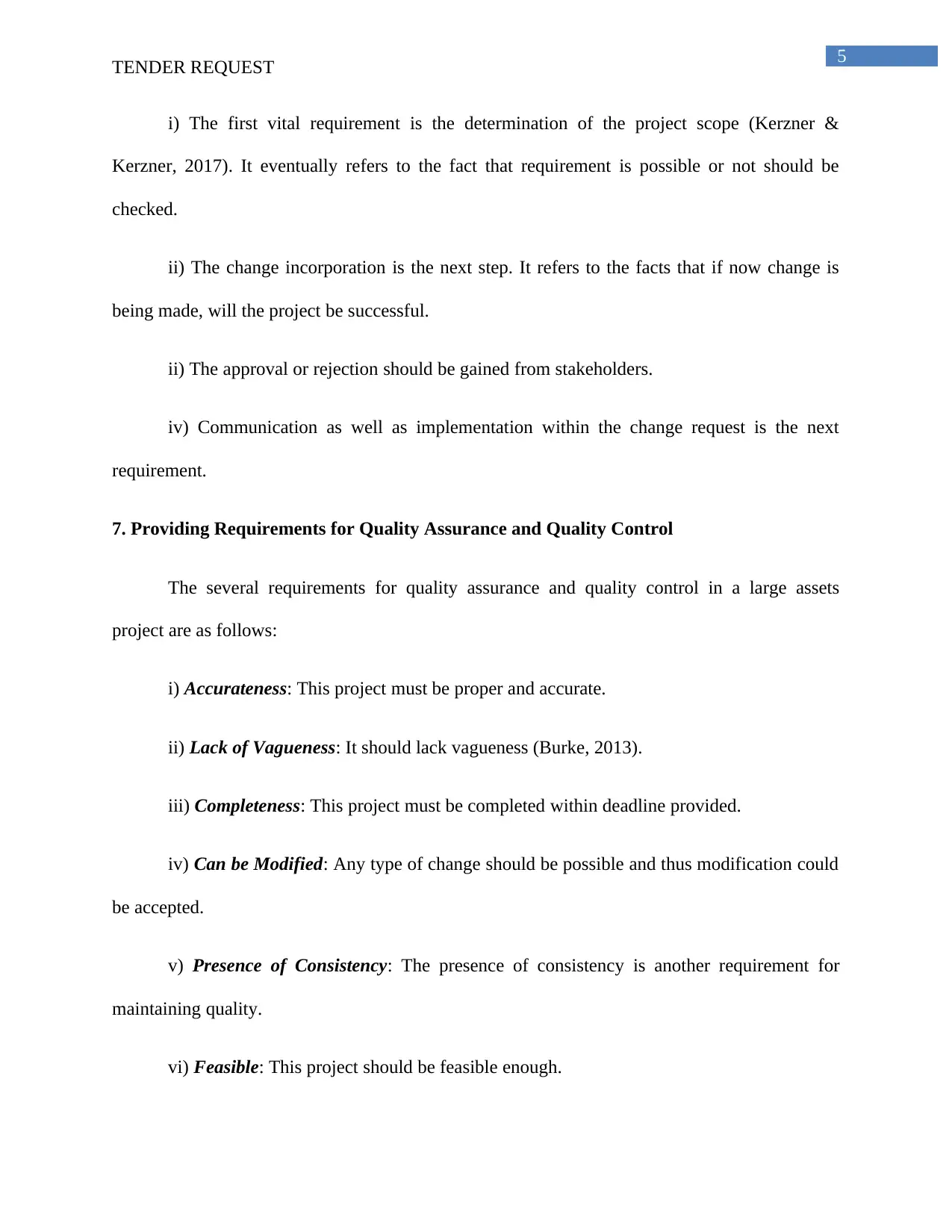
5
TENDER REQUEST
i) The first vital requirement is the determination of the project scope (Kerzner &
Kerzner, 2017). It eventually refers to the fact that requirement is possible or not should be
checked.
ii) The change incorporation is the next step. It refers to the facts that if now change is
being made, will the project be successful.
ii) The approval or rejection should be gained from stakeholders.
iv) Communication as well as implementation within the change request is the next
requirement.
7. Providing Requirements for Quality Assurance and Quality Control
The several requirements for quality assurance and quality control in a large assets
project are as follows:
i) Accurateness: This project must be proper and accurate.
ii) Lack of Vagueness: It should lack vagueness (Burke, 2013).
iii) Completeness: This project must be completed within deadline provided.
iv) Can be Modified: Any type of change should be possible and thus modification could
be accepted.
v) Presence of Consistency: The presence of consistency is another requirement for
maintaining quality.
vi) Feasible: This project should be feasible enough.
TENDER REQUEST
i) The first vital requirement is the determination of the project scope (Kerzner &
Kerzner, 2017). It eventually refers to the fact that requirement is possible or not should be
checked.
ii) The change incorporation is the next step. It refers to the facts that if now change is
being made, will the project be successful.
ii) The approval or rejection should be gained from stakeholders.
iv) Communication as well as implementation within the change request is the next
requirement.
7. Providing Requirements for Quality Assurance and Quality Control
The several requirements for quality assurance and quality control in a large assets
project are as follows:
i) Accurateness: This project must be proper and accurate.
ii) Lack of Vagueness: It should lack vagueness (Burke, 2013).
iii) Completeness: This project must be completed within deadline provided.
iv) Can be Modified: Any type of change should be possible and thus modification could
be accepted.
v) Presence of Consistency: The presence of consistency is another requirement for
maintaining quality.
vi) Feasible: This project should be feasible enough.
⊘ This is a preview!⊘
Do you want full access?
Subscribe today to unlock all pages.

Trusted by 1+ million students worldwide
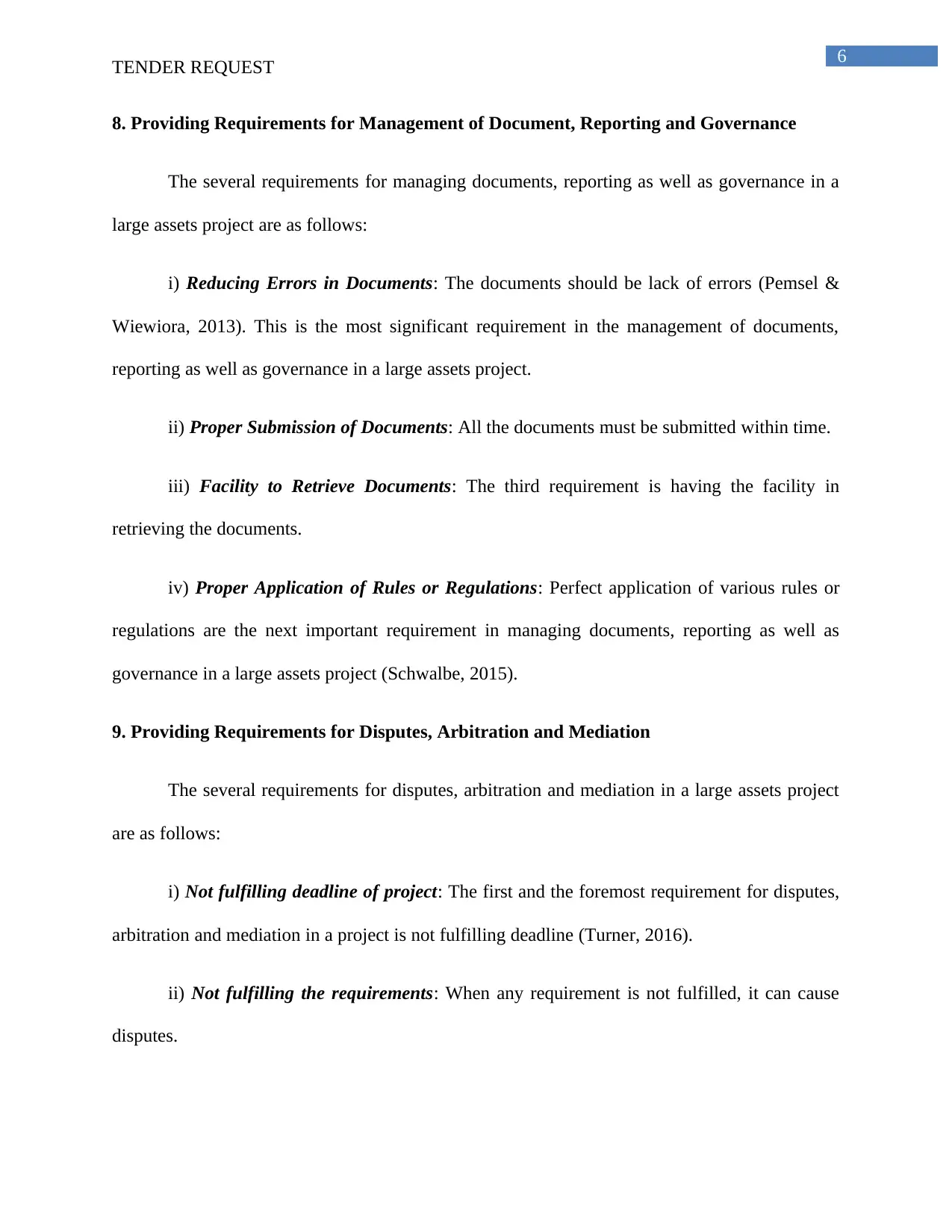
6
TENDER REQUEST
8. Providing Requirements for Management of Document, Reporting and Governance
The several requirements for managing documents, reporting as well as governance in a
large assets project are as follows:
i) Reducing Errors in Documents: The documents should be lack of errors (Pemsel &
Wiewiora, 2013). This is the most significant requirement in the management of documents,
reporting as well as governance in a large assets project.
ii) Proper Submission of Documents: All the documents must be submitted within time.
iii) Facility to Retrieve Documents: The third requirement is having the facility in
retrieving the documents.
iv) Proper Application of Rules or Regulations: Perfect application of various rules or
regulations are the next important requirement in managing documents, reporting as well as
governance in a large assets project (Schwalbe, 2015).
9. Providing Requirements for Disputes, Arbitration and Mediation
The several requirements for disputes, arbitration and mediation in a large assets project
are as follows:
i) Not fulfilling deadline of project: The first and the foremost requirement for disputes,
arbitration and mediation in a project is not fulfilling deadline (Turner, 2016).
ii) Not fulfilling the requirements: When any requirement is not fulfilled, it can cause
disputes.
TENDER REQUEST
8. Providing Requirements for Management of Document, Reporting and Governance
The several requirements for managing documents, reporting as well as governance in a
large assets project are as follows:
i) Reducing Errors in Documents: The documents should be lack of errors (Pemsel &
Wiewiora, 2013). This is the most significant requirement in the management of documents,
reporting as well as governance in a large assets project.
ii) Proper Submission of Documents: All the documents must be submitted within time.
iii) Facility to Retrieve Documents: The third requirement is having the facility in
retrieving the documents.
iv) Proper Application of Rules or Regulations: Perfect application of various rules or
regulations are the next important requirement in managing documents, reporting as well as
governance in a large assets project (Schwalbe, 2015).
9. Providing Requirements for Disputes, Arbitration and Mediation
The several requirements for disputes, arbitration and mediation in a large assets project
are as follows:
i) Not fulfilling deadline of project: The first and the foremost requirement for disputes,
arbitration and mediation in a project is not fulfilling deadline (Turner, 2016).
ii) Not fulfilling the requirements: When any requirement is not fulfilled, it can cause
disputes.
Paraphrase This Document
Need a fresh take? Get an instant paraphrase of this document with our AI Paraphraser
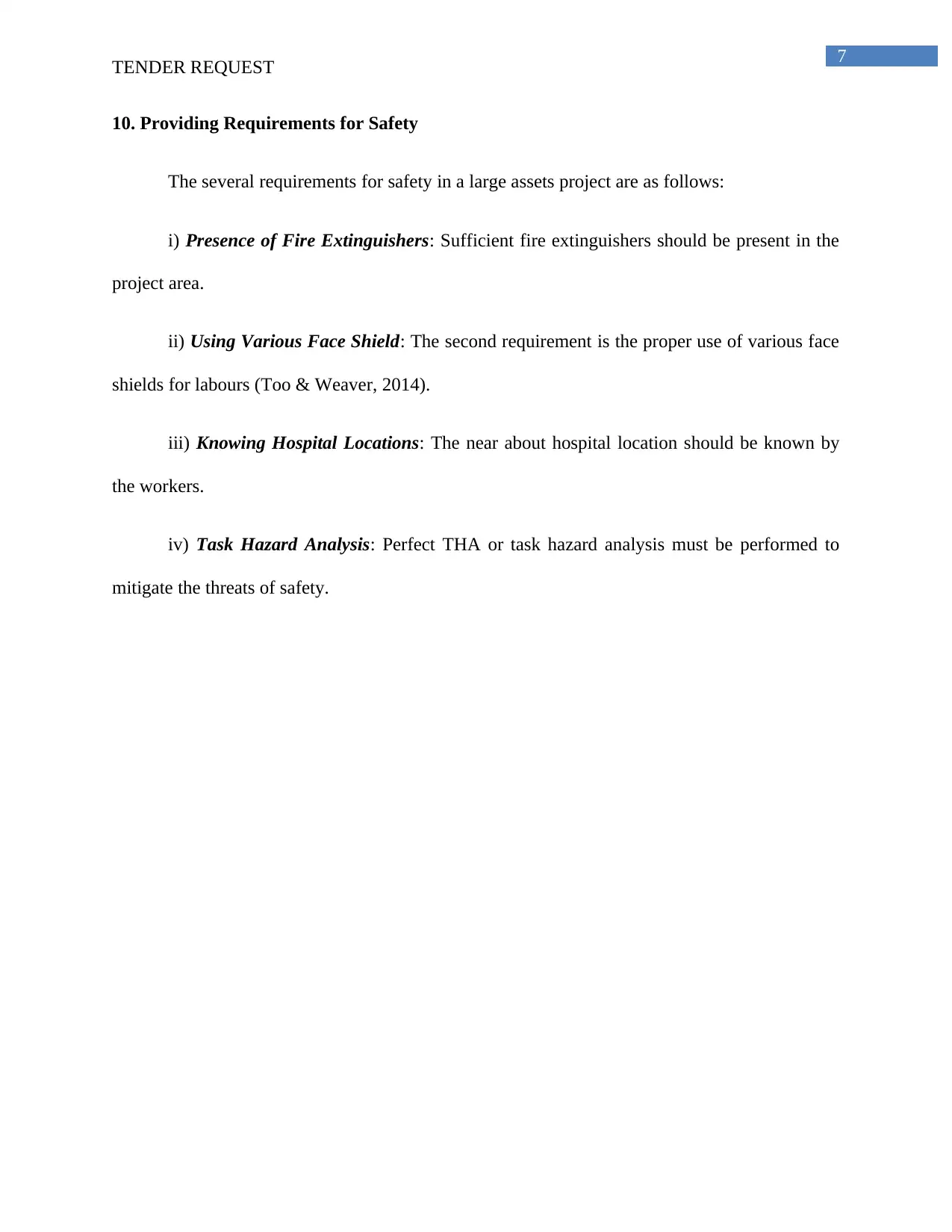
7
TENDER REQUEST
10. Providing Requirements for Safety
The several requirements for safety in a large assets project are as follows:
i) Presence of Fire Extinguishers: Sufficient fire extinguishers should be present in the
project area.
ii) Using Various Face Shield: The second requirement is the proper use of various face
shields for labours (Too & Weaver, 2014).
iii) Knowing Hospital Locations: The near about hospital location should be known by
the workers.
iv) Task Hazard Analysis: Perfect THA or task hazard analysis must be performed to
mitigate the threats of safety.
TENDER REQUEST
10. Providing Requirements for Safety
The several requirements for safety in a large assets project are as follows:
i) Presence of Fire Extinguishers: Sufficient fire extinguishers should be present in the
project area.
ii) Using Various Face Shield: The second requirement is the proper use of various face
shields for labours (Too & Weaver, 2014).
iii) Knowing Hospital Locations: The near about hospital location should be known by
the workers.
iv) Task Hazard Analysis: Perfect THA or task hazard analysis must be performed to
mitigate the threats of safety.
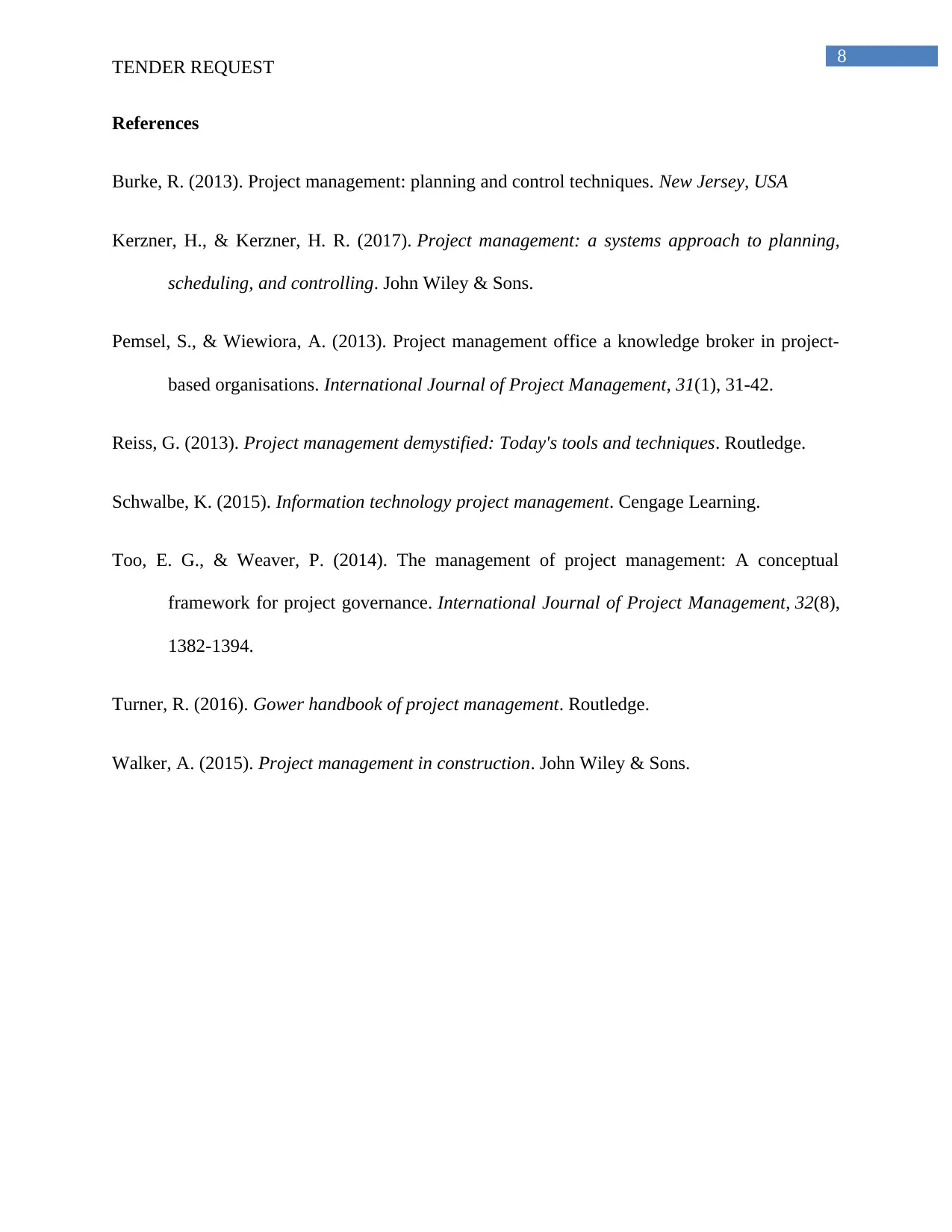
8
TENDER REQUEST
References
Burke, R. (2013). Project management: planning and control techniques. New Jersey, USA
Kerzner, H., & Kerzner, H. R. (2017). Project management: a systems approach to planning,
scheduling, and controlling. John Wiley & Sons.
Pemsel, S., & Wiewiora, A. (2013). Project management office a knowledge broker in project-
based organisations. International Journal of Project Management, 31(1), 31-42.
Reiss, G. (2013). Project management demystified: Today's tools and techniques. Routledge.
Schwalbe, K. (2015). Information technology project management. Cengage Learning.
Too, E. G., & Weaver, P. (2014). The management of project management: A conceptual
framework for project governance. International Journal of Project Management, 32(8),
1382-1394.
Turner, R. (2016). Gower handbook of project management. Routledge.
Walker, A. (2015). Project management in construction. John Wiley & Sons.
TENDER REQUEST
References
Burke, R. (2013). Project management: planning and control techniques. New Jersey, USA
Kerzner, H., & Kerzner, H. R. (2017). Project management: a systems approach to planning,
scheduling, and controlling. John Wiley & Sons.
Pemsel, S., & Wiewiora, A. (2013). Project management office a knowledge broker in project-
based organisations. International Journal of Project Management, 31(1), 31-42.
Reiss, G. (2013). Project management demystified: Today's tools and techniques. Routledge.
Schwalbe, K. (2015). Information technology project management. Cengage Learning.
Too, E. G., & Weaver, P. (2014). The management of project management: A conceptual
framework for project governance. International Journal of Project Management, 32(8),
1382-1394.
Turner, R. (2016). Gower handbook of project management. Routledge.
Walker, A. (2015). Project management in construction. John Wiley & Sons.
⊘ This is a preview!⊘
Do you want full access?
Subscribe today to unlock all pages.

Trusted by 1+ million students worldwide
1 out of 9
Related Documents
Your All-in-One AI-Powered Toolkit for Academic Success.
+13062052269
info@desklib.com
Available 24*7 on WhatsApp / Email
![[object Object]](/_next/static/media/star-bottom.7253800d.svg)
Unlock your academic potential
Copyright © 2020–2025 A2Z Services. All Rights Reserved. Developed and managed by ZUCOL.




